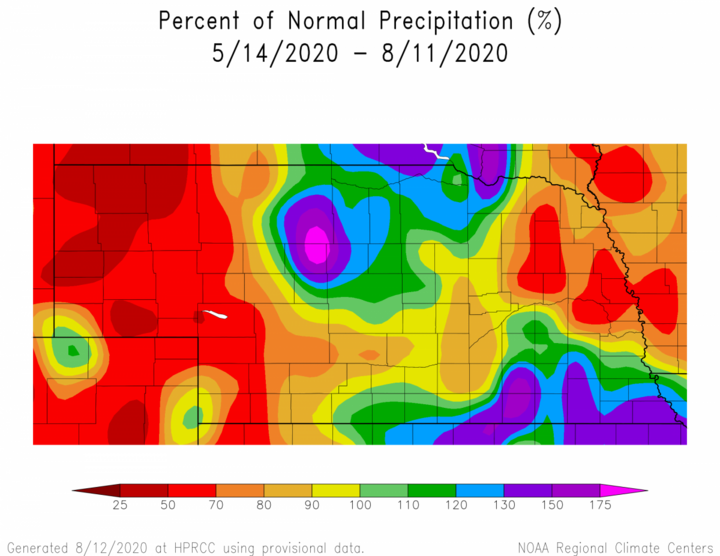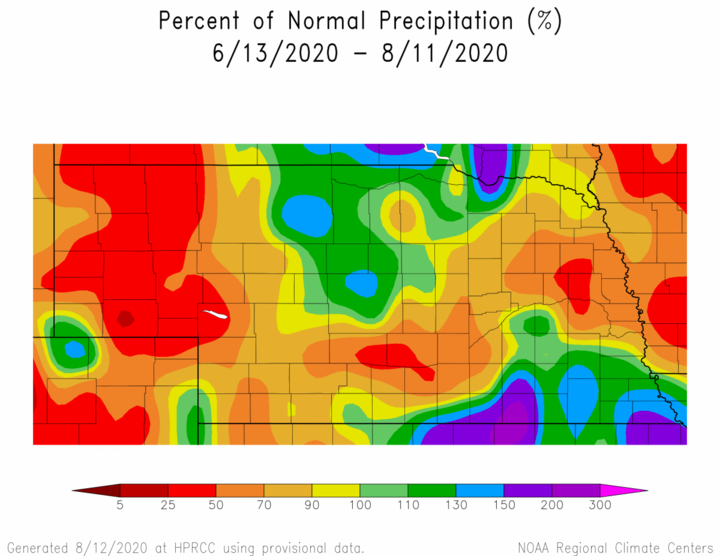The following are factors that are known to impact pollination:
- Heat over 95°F depresses pollen production.
- Prolonged periods of heat can reduce pollen production and viability.
- High humidity, without a drop in humidity during the day, can delay pollination or prevent pollen from leaving anther sacs.
- When soil moisture is sufficient, one day of 95-98°F has little or no impact on yields. After four consecutive days, there can be a 1% loss in yield for each day above that temperature. Greater yield loss potential occurs after the fifth or sixth day.
- This year, additional stress factors such as rootworm beetle and Japanese beetle silk clipping and windstorm damage may have also impacted pollination and/or kernel set.
Temperatures During Pollination and Early Grain Fill
For this year having what seemed to be good pollination weather, some are surprised regarding how much tip back we’re seeing (Figure 1). It’s important to count kernels long as there may be more kernels than one realizes in spite of tip back occurring.
Table 1 shows that overall Nebraska locations had few days during the pollination period where max temperatures were 95°F or above. Western Nebraska had more days of higher temperatures than Eastern Nebraska which could add some stress.
However, Eastern Nebraska had an increased number of minimum temperatures staying above 70°F at night. The survival of developing kernels can also be impacted by warm nights during pollination and early grain fill. Higher night-time temperatures increase respiration in the plant which burns photosynthate that should go into grain fill. They also push kernels to mature quicker.
Tip back on corn occurs most often from some sort of stress. One can tell the approximate timing of stress events by the appearance of the kernels. If kernel formation isn’t evident, the stress occurred before or during pollination. If kernels are very small or appeared to have died, the stress was after pollination as the kernels were filling.

| Scottsbluff | Ainsworth | Concord | Central City | Mead | Curtis | Clay Center | Plymouth | |
|---|---|---|---|---|---|---|---|---|
| 6/28-7/5: 5* | ||||||||
| Max Temp 90 | 5 | 2 | 0 | 0 | 0 | 4 | 0 | 0 |
| Max Temp 95 | 2 | 0 | 0 | 0 | 0 | 1 | 0 | 0 |
| Min Temp 70 | 0 | 1 | 1 | 1 | 1 | 0 | 1 | 2 |
| Min Temp 75 | 0 | 0 | 0 | 0 | 0 | 0 | 1 | 0 |
| Avg Wind 10 | 0 | 0 | 0 | 0 | 0 | 0 | 0 | 0 |
| Wind Gust 20 | 5 | 2 | 1 | 1 | 0 | 1 | 0 | 1 |
| Wind Gust 30 | 3 | 0 | 0 | 1 | 0 | 0 | 0 | 0 |
| 7/6-7/12: 19* | ||||||||
| Max Temp 90 | 7 | 3 | 0 | 0 | 2 | 5 | 1 | 1 |
| Max Temp 95 | 3 | 0 | 0 | 0 | 0 | 2 | 0 | 0 |
| Min Temp 70 | 0 | 0 | 0 | 0 | 1 | 0 | 0 | 0 |
| Min Temp 75 | 0 | 0 | 0 | 0 | 0 | 0 | 0 | 0 |
| Avg Wind 10 | 0 | 2 | 0 | 1 | 0 | 1 | 0 | 0 |
| Peak Gust 20 | 3 | 3 | 4 | 5 | 1 | 4 | 3 | 3 |
| Peak Gust 30 | 0 | 2 | 1 | 2 | 0 | 2 | 1 | 2 |
| 7/13-7/19: 61* | ||||||||
| Max Temp 90 | 3 | 1 | 2 | 3 | 2 | 4 | 2 | 1 |
| Max Temp 95 | 1 | 1 | 0 | 1 | 1 | 3 | 0 | 0 |
| Min Temp 70 | 0 | 1 | 0 | 1 | 1 | 0 | 2 | 2 |
| Min Temp 75 | 0 | 0 | 0 | 0 | 1 | 0 | 0 | 1 |
| Avg Wind 10 | 0 | 1 | 0 | 0 | 0 | 0 | 0 | 0 |
| Wind Gust 20 | 2 | 1 | 2 | 1 | 0 | 1 | 1 | 0 |
| Wind Gust 30 | 0 | 0 | 0 | 0 | 0 | 0 | 0 | 0 |
| 7/20-7/26: 99* | ||||||||
| Max Temp 90 | 4 | 1 | 1 | 1 | 2 | 4 | 1 | 1 |
| Max Temp 95 | 1 | 0 | 0 | 0 | 0 | 2 | 0 | 0 |
| Min Temp 70 | 0 | 1 | 3 | 3 | 3 | 0 | 3 | 3 |
| Min Temp 75 | 0 | 0 | 0 | 0 | 0 | 0 | 0 | 0 |
| Avg Wind 10 | 0 | 2 | 2 | 2 | 0 | 1 | 0 | 0 |
| Wind Gust 20 | 2 | 3 | 2 | 2 | 0 | 3 | 0 | 1 |
| Wind Gust 30 | 1 | 1 | 0 | 0 | 0 | 0 | 0 | 0 |
Water Stress
What the above weather data can’t tell us is if the plants were already in drought stress or approaching it.
Water stress is a major stress outside of temperature as to kernels not pollinating and/or aborting. Each ovule (and later, each kernel), competes for water and nutrients. Water and nutrients are necessary for pollen tube formation down silks to fertilize ovules. Water and nutrients are also necessary to fill individual kernels with the tips being sacrificed for filling kernels at the base of the ear first.
The latest U.S. Drought Monitor depiction for Nebraska found in Figure 2 shows drought conditions across the western 1/3 of the state, the central Platte valley, and the eastern half of northeast and east central Nebraska. Dryness across the Panhandle extends as far back as last fall in the northwest corner, while dryness across the eastern half of the state is related to precipitation tendencies this growing season.

Looking at the precipitation tendencies for the past 90 days, most of the western 1/3 of the state has received less than 70% of normal precipitation, while small pockets of similar tendencies exist across northeast Nebraska (Figure 3). Dryness has been more intense over the past 60 days, with these same areas receiving less than 50% of normal as shown in Figure 4. Furthermore, a sizeable area of the state outside of these areas has received 50-70% of normal moisture.


The 90 day maps will lose the last half of May’s precipitation, a rather wet period, over the next two weeks. Barring an unexpected heavy precipitation event, the amount of area below 70% of normal is likely to expand and cover more of central Nebraska. Translated into simplified terms, precipitation deficits for the growing season will be greater than 6 inches from central through northeast Nebraska.
For areas that have received less than 50% of normal moisture the past 60 days and/or less than 70% of normal the last 90 days, soil moisture should be nearly exhausted and stress readily apparent. The cooler temperatures the past two weeks may be masking some of these stresses, but corn ear tip back should be starting to appear and will likely intensify if the forecasted dryness through the end of the month materializes.
Additional Resources
Hoegemeyer, T., J. Rees, A. Dutcher, T. Williams. 2019. How Extended High Heat Disrupts Corn Pollination
Strachan, Stephen D. Corn Grain Yield in Relation to Stress During Ear Development
